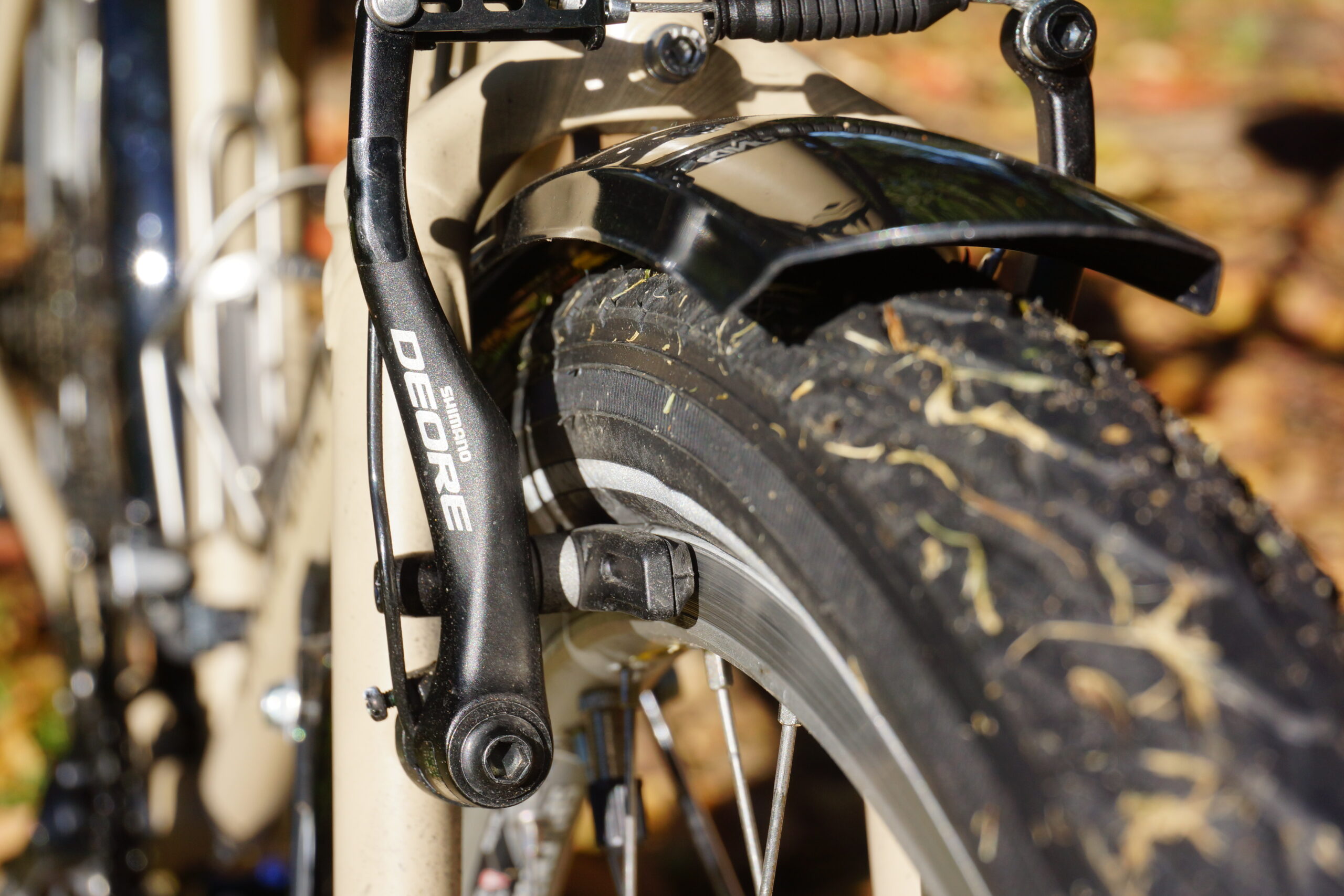This is #4 in an ever-growing series of answers to frequently-asked questions about touring bikes. If you’re new here, why not start with #1: What Exactly Defines A Touring Bike?
While many high-end touring bikes are nowadays fitted with disc brakes, there’s still plenty of debate over whether V‑brakes or disc brakes are actually ‘better’ for touring.
And, as usual, there’s no clear-cut answer. I’m sorry about that.
V‑brakes, for the purposes of this post, are a generic and misused term for the several varieties of caliper brakes that work by pinching the bicycle wheel’s rim between two brake blocks to create friction and slow the bike.

Disc brakes on touring bikes are relatively new, appearing gradually on mainstream touring bikes over the last decade or so.
They were originally hydraulically actuated, having been modified and transplanted from motorbikes for the high-end mountain biking market.
Later, cable-actuated disc brakes appeared, using the same steel cables, housings and levers as V‑brakes. All disc brakes are characterised by having calipers that act upon a metal ‘rotor’, or disc, which is bolted onto the wheel hub. The braking surface of the wheel rim is not used.

The big debate originally arose because disc brakes were a departure from traditional established touring bike design, which exclusively used cantilever or V‑brakes acting on the wheel rims. Tourers are generally reluctant to risk the reliability of their rides on new-fangled technology.
As the years passed, however, several models of cable-actuated disc brake started to prove their reliability on a growing number of round the world rides, with the TRP Spyre series seen most frequently.
That they are now fitted as standard on some of the most popular touring bikes available is a reflection of the fact that disc brakes have crossed over from ‘new-fangled’ to ‘tried and tested’ – as well as there being several objective advantages to using disc brakes over V‑brakes on tour.
The case for disc brakes on touring bikes
Disc brakes’ advantages over V‑brakes mainly lie in their braking functionality. They offer a finer degree of control over braking, known as ‘modulation’. All else being equal, they can also provide slightly more stopping power. With fully-loaded touring bikes easily weighing three or four times the weight of an unloaded bike, the prospect of an increase in braking power is a tempting one.
For ultra long-term tours, disc brakes offer another perceived advantage: they won’t wear out your wheel rims. It takes far longer to wear out a disc brake rotor with disc brakes than it does to wear out a wheel rim with V‑brakes. This is accentuated in wet, dirty conditions when grit and crap on V‑brakes will grind away at wheel rims like sandpaper.
In the long term, using V‑brakes will more or less guarantee that you’ll need to replace the wheels of your bike, or rebuild them onto new rims, at some point (you will get plenty of advance warning of this if you keep your eyes open; most good rims feature wear indicators for just this purpose).
Most long-haul tourers seem happy enough knowing this, and plan or prepare accordingly. They also know that a wheel is as likely to need rebuilding because of snapped spokes or worn-out hubs as it is because of a worn braking surface.
The case for V‑brakes on touring bikes
In this light, it’s easy to see V‑brakes as an old-hat, low-budget, sub-optimal choice for braking. But this is not true.
The braking power argument is often given undue importance. It might well help a downhill mountain biker win a race, and that’s why mountain bikers love hydraulic disc brakes – but that’s very different to 99.9% of the scenarios a touring cyclist could expect to encounter.
We’ve all ridden bikes with crap V‑brakes that are poorly installed and badly maintained, but a properly-adjusted set of modern V‑brakes can deliver a similar level of raw braking power to a cable disc brake, given due care and attention.
So that’s why you’ll still find V‑brakes fitted to tourers with price-tags well into the thousands of pounds. At the end of the day, they simply work. They’ve been doing so since bicycles were invented.
Rim brakes have one huge advantage for the long-haul traveller: compatible parts can be found in one form or another on almost every bike on the planet, whereas disc brakes still rely on non-standard, proprietary brake pads and calipers.
Rim brakes operate upon the simplest possible principles, and if kept properly adjusted they’ll do the same job of stopping a fully-loaded touring bike that they’ve been doing for decades. There’s a huge amount to be said for that simplicity.
As with so many noisy debates in touring equipment choice, then, the underlying point is easily forgotten. And in the case of brake technology, the more important question is not whether rim brakes or disc brakes are ‘better’. At the end of the day, they both stop bikes.
The real question is which would be more appropriate for your tour.
Tackling lots of big mountains and/or dirt-road bikepacking in the short term? You might well benefit from the increased control and power of disc brakes.
Riding round the world for the next few years? Your priorities are likely to be better served by the simplicity, durability, ease of adjustment and the availability of spares that come with V‑brakes.
Next in the Touring Bike FAQ series: Derailleurs or Internal Hub Gears (Rohloff)?


Something to add?